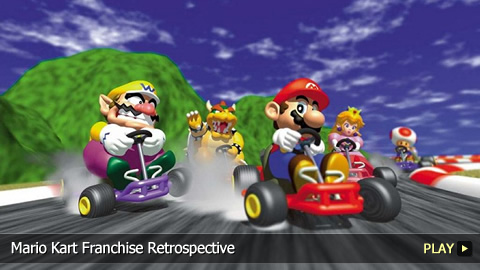Mario Kart Franchise Retrospective

He doesn’t just jump across the Mushroom Kingdom; he zips across it at over 50ccs. Welcome to WatchMojo.com and today we’ll be taking a look back at the Mario Kart franchise.
Most people have grown up playing the mustachioed plumber’s countless adventures. Yet, his exploits behind the wheel have become just as recognizable as his core series. This is not only due to attracting a following through multiplayer mayhem, but providing the first-ever go-cart experience within a console game.
One of the longest running and best-known spinoffs series ever made, Mario Kart debuted in 1992 for the Super Nintendo. Its original 16-bit game “Super Mario Kart” launched the series only one year after the release of the incredibly popular “Super Mario World.”
Due to this, it pitted players against each other as they raced through signature areas from that game. Unsurprisingly, this method of supporting Mario’s latest adventures with four-wheeled counterparts became commonplace, such as in 1997’s Mario Kart 64”, which not only introduced 3D graphics, but 4-player play to the series.
No matter the installment, the games have always had players select from the most popular characters from the Mario universe. Each even featured their own agility and speed traits, and made extensive use power-ups items. These included star power, bananas, mushrooms and the infamous leader-seeking Blue Turtle Shell, which players used to gain the upper hand against their friends and the computer. Of course, certain characters have always been prone to receiving one type of item over another, such as Toad constantly collecting Mushroom speed boosts.
In terms of tracks, Mario Kart has always separated races by unique Cup challenges. These have included such challenges as the Mushroom Cup, Fireflower Cup, Lightening Cup and Star Cup, along with Mirror and Retro Cups. These each contain several courses, while difficulty and skill is further divided by the selectable speed of the vehicle motor, which ranges from 50ccs up to 150ccs.
While there are always new tracks and retro throwbacks, the series is known for featuring regular staples. Among these are beaches, stadiums, Bowser’s Castle and the fall-defying and massive Rainbow Road. Despite the setting, the races have always been intense and close, due in large part to Nintendo’s use of rubber-banding AI enemies. This means that no matter what you throw at them, they’ll usually manage to stay one step behind or ahead of you.
Meanwhile, the racing series has always sported a Ghost mode so players could race themselves, and a thrilling Battle Mode. This includes a balloon challenge, which has players try and pop each other’s three balloons in order to win.
Not just a staple of each and every one of Nintendo’s home consoles since the early 90s, Mario Kart has regularly appeared on their portable systems as well. As a result, the series has felt the need to innovate and make drastic changes in order to keep things fresh. These various gimmicks have ranged from the use of two passenger vehicles in “Mario Kart: Double Dash!!”, to motorcycles in “Mario Kart Wii”, and more recently gliders and submarines in Mario Kart 7. Interestingly, this is in fact the 9th entry in the series if you count its two Namco-led Arcade GP romps.
An iconic series, Mario Kart continues to lead the way for fun on Nintendo platforms, and other companies continue to unsuccessfully mimic its remarkable success and universal appeal.
